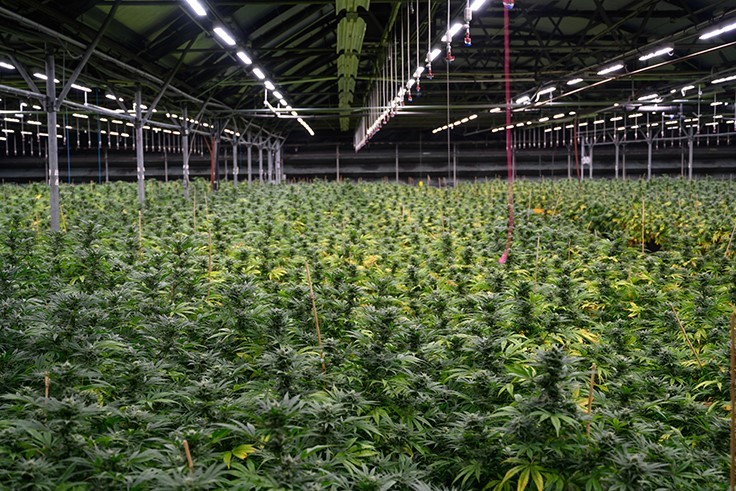How Cannabis Cultivators Can Factor DLI into Their Lighting Plans
Marijuana Industry News June 13, 2019 MJ Shareholders

Maintaining a uniform light level for cannabis crops year-round is the best way to ensure consistency, uniformity and predictability in production. Understanding daily light integral (DLI) is the best way for greenhouse and indoor growers to decide on the best approach to lighting in their facilities, according to Travis Higginbotham, director of global horticulture services for Fluence by OSRAM.
When deciding on a lighting strategy, growers often consider three characteristics: light quality, or the spectra of light being applied; light intensity, or the amount of light that reaches the plant in a single second in a square meter; and photoperiod, which is the length of the day that light is applied to the plant. DLI is an accumulation reading of how much light the plant has received within the entire photoperiod, and it is measured in moles per day.
DLI is most often considered in greenhouses, where additional lighting is usually needed to supplement the natural light that plants receive from the sun. A greenhouse grower may aim to have a 12-hour photoperiod in a single 24-hour timeframe, when the sun is out, and there is a bell curve of light intensity throughout that photoperiod—the sun rises, the light gets gradually more intense and peaks mid-day, and then it slowly decreases intensity toward the end of the day, before the sun sets.
However, during that 12-hour photoperiod, clouds, rain, the time of year and geographic location of the grow can change how much light the plants actually receive. Therefore, growers can use DLI to determine how much light is actually being applied to the plants naturally. James Faust of Clemson University and Joanne Logan of the University of Tennessee have published DLI maps by each month of the year to see available light in your region. This tool allows growers to better manage the light environment of their plants depending on their location.
Veteran growers have an intuitive understanding of their local light levels, but without fully understanding how DLI changes due to a number of factors, growers can sometimes make poor choices in terms of supplemental lighting strategies as they manage different regional grows, Higginbotham says. “A key thing growers need to keep in mind is, when do they want to start implementing supplemental lighting? For some, starting in the fall, throughout the winter, and ending in early spring is the right choice. The reason being, as natural light levels go down during the year, supplementing this way compensates for the difference. With this strategy, the grower can hold a similar DLI throughout the entire year. Ideally, this would allow them to keep uniform and consistent crops throughout the whole year.”
DLI can be measured on a scale from 1 to 70. Cannabis can tolerate a DLI as high as 65 , Higginbotham says, which is a tremendous amount of light. (Petunias, he says, thrive with a DLI of 6, while begonias typically thrive under 11). Nowhere in the U.S. receives a 65 DLI from the sun, even in the peak of summer, Higginbotham says. Thus, supplemental lighting is needed, even in greenhouses where the plants receive natural light.
Indoors, where there is no solar radiation, plants get a continuous, fixed light intensity level throughout the entire photoperiod, and DLI is converted into photosynthetic photon flux density (PPFD), which tells growers how much light the plant is receiving per second. Growers can then use PPFD readings to calculate the accumulation throughout the entire photoperiod, which becomes moles per day—a DLI reading. Growers can therefore use PPFD to determine how much light and which lighting solution to use in their facilities, particularly when it comes to different stages of plant growth.
“With indoor, you don’t talk so much about DLI, except when you get into trying to help the grower understand the difference in lighting application between vegetative growth and flowering growth,” Higginbotham says. “The photoperiod during vegetative growth is 18 hours, and then the photoperiod during flowering is 12, as of right now. For the sake of this example let’s simplify the math and say that you applied 500 PPFD in veg and 500 PPFD in flower. You still have two very different DLIs because the length of time that light is applied is very different.”
An 18-hour photoperiod in veg with 500 micromoles per metered square per second calculates to a DLI of 32, for example. In flower, a 12-hour photoperiod at the same light intensity level is a DLI of 21.
“When growers … choose the same light level for both stages, they still have a completely different level of light accumulation. Cannabis can tolerate very high light intensities, so why would anyone go with the same light intensity level in flower as you would in veg, when we know you could go even higher and have a much more productive plant?” Higginbotham says. “So, photoperiod can really teach you a lot in regard to understanding how much light cannabis can actually accumulate and is an important metric to consider.”
MJ Shareholders
MJShareholders.com is the largest dedicated financial network and leading corporate communications firm serving the legal cannabis industry. Our network aims to connect public marijuana companies with these focused cannabis audiences across the US and Canada that are critical for growth: Short and long term cannabis investors Active funding sources Mainstream media Business leaders Cannabis consumers









